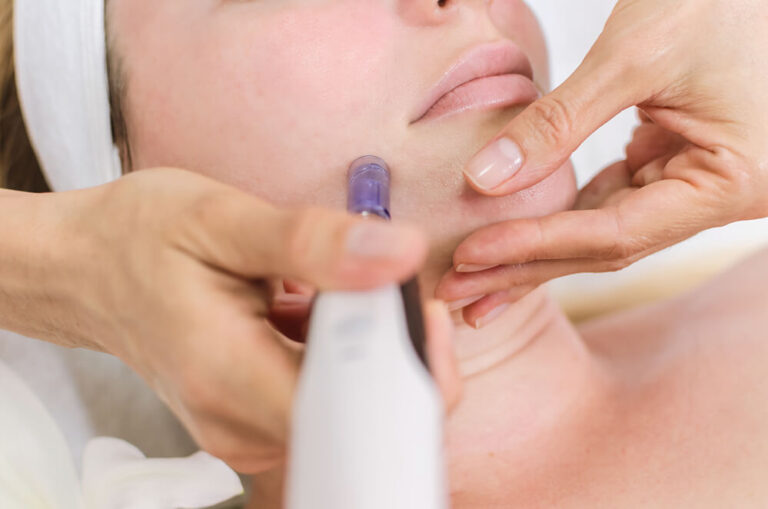Microneedling has become a popular cosmetic treatment for various skin concerns, including hyperpigmentation. Hyperpigmentation is a common skin condition that causes the skin to darken in certain areas due to an overproduction of melanin. It can be caused by a variety of factors, including sun exposure, hormonal changes, and skin injuries.
Microneedling, also known as collagen induction therapy, is a minimally invasive procedure that involves using a device with fine needles to create tiny punctures in the skin. This process stimulates the production of collagen and elastin, which can help to improve the overall texture and appearance of the skin. In addition, microneedling can also be an effective treatment for hyperpigmentation.
Key Takeaways
- Microneedling can be an effective treatment for hyperpigmentation by breaking up excess melanin and stimulating the production of new, healthy skin cells.
- Microneedling is a safe and effective alternative to other hyperpigmentation treatments, such as chemical peels and laser therapy.
Mechanism of Microneedling for Hyperpigmentation
Microneedling is a minimally invasive cosmetic procedure that involves puncturing the skin with tiny needles to stimulate skin repair and rejuvenation. It has been found to be effective in treating hyperpigmentation, a common skin condition characterized by the appearance of dark patches on the skin.
Skin Penetration
The microneedles used in the procedure create microchannels in the skin, which allows for better penetration of topical agents. This is important in the treatment of hyperpigmentation because it allows for the delivery of skin-lightening agents directly to the affected areas of the skin. Microneedling also increases blood flow to the treated area, which helps to remove pigmented cells and promote the growth of new, healthy skin cells.
Stimulating Collagen Production
Microneedling also stimulates the production of collagen, a protein that is essential for skin health and repair. Collagen helps to improve skin texture and tone, and can also help to reduce the appearance of hyperpigmentation. As the skin heals after microneedling, collagen is produced in greater quantities, which helps to improve the overall appearance of the skin.
Benefits of Microneedling for Hyperpigmentation
Microneedling is a minimally invasive cosmetic procedure that involves using a device with tiny needles to puncture the skin. This procedure is gaining popularity as a treatment for hyperpigmentation, a common skin condition characterized by dark patches on the skin. Here are some benefits of microneedling for hyperpigmentation:
- Stimulates Collagen Production: Microneedling creates micro-injuries in the skin, which triggers the body’s natural healing process. This process includes the production of collagen, a protein that gives the skin its structure and elasticity. Increased collagen production can help improve the appearance of hyperpigmentation by reducing the appearance of dark spots and promoting even skin tone.
- Increases Product Absorption: Microneedling creates tiny channels in the skin that allow topical products to penetrate deeper into the skin. This can enhance the effectiveness of topical treatments for hyperpigmentation, such as skin lightening creams or vitamin C serums.
- Improves Skin Texture: In addition to reducing hyperpigmentation, microneedling can also improve the overall texture of the skin. This is because the procedure can help reduce the appearance of fine lines, wrinkles, and acne scars.
Can Microneedling cause Hyperpigmentation
Microneedling is a minimally invasive cosmetic procedure that involves pricking the skin with tiny needles to stimulate collagen production and improve skin texture. While it is generally considered safe and effective for treating various skin conditions, including hyperpigmentation, there is a concern that it may cause hyperpigmentation in some cases.
Hyperpigmentation is a common skin condition characterized by the darkening of the skin due to the overproduction of melanin, the pigment that gives skin its color. It can be caused by various factors, including sun exposure, hormonal changes, and skin injuries.
Some studies have suggested that microneedling may cause hyperpigmentation, particularly in people with darker skin tones. This is because the procedure can trigger the skin’s natural defense mechanism, which includes the production of melanin. In some cases, this can lead to the formation of dark spots or patches on the skin.
Microneedling vs Other Hyperpigmentation Treatments
When it comes to treating hyperpigmentation, there are several options available, including chemical peels, laser treatments, and topical creams. However, microneedling has emerged as a popular and effective treatment option.
One of the biggest advantages of microneedling is that it is minimally invasive. Unlike chemical peels and laser treatments, which can cause significant discomfort and downtime, microneedling typically involves only mild redness and swelling for a few days after the procedure.
Another advantage of microneedling is that it can be used on all skin types, including darker skin tones. Some other treatments, such as certain types of laser therapy, may not be safe or effective for individuals with darker skin.
Microneedling can also be combined with other treatments, such as topical serums or platelet-rich plasma (PRP) therapy, to enhance its effects. This can be particularly beneficial for individuals with stubborn or severe hyperpigmentation.
Conclusion
Microneedling is a promising treatment option for hyperpigmentation. The procedure involves creating tiny punctures in the skin with a device that contains fine needles. This stimulates the production of collagen and elastin, which can improve the appearance of hyperpigmentation.
Studies have shown that microneedling can be effective in reducing hyperpigmentation caused by a variety of factors, including acne, melasma, and sun damage. However, it is important to note that results may vary depending on the severity of the hyperpigmentation and the individual’s skin type.



